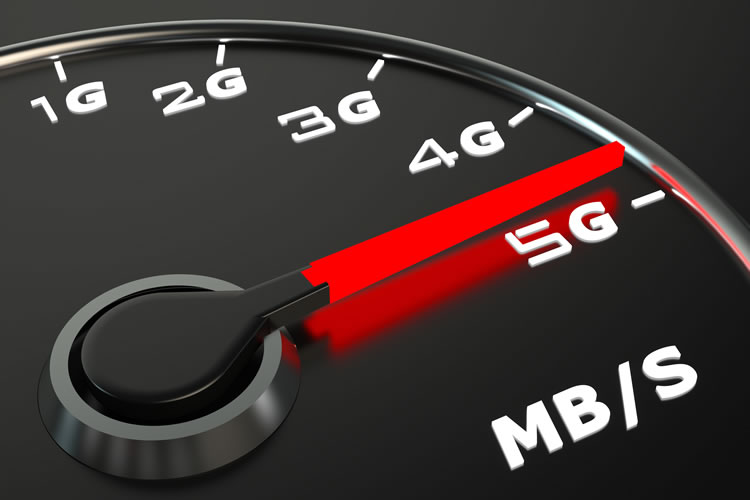
With 5G now quite widely available across the UK on all four main networks, as well as being offered by a large number of MVNOs, now’s the time when you might want to jump on board, but you might also be wondering just how much of an upgrade over 4G it really is?
The short answer is that it’s a massive upgrade. It’s enormously faster, designed to provide huge capacity, and is even set to support a wide range of innovative new services across different industries.
We’ve put the two techs head-to-head across various categories to give you an idea of just how much better 5G is, and how much more it will enable.
DOWNLOAD SPEED
5G is already much, much faster than 4G, and in future it could make even high-speed fibre broadband seem sluggish, as speeds are likely to improve.
Right now, the average 5G speeds claimed by networks in the UK are around 100-250Mbps, with peak speeds apparently reaching over 1Gbps. That upper claim might be optimistic, as the top speed we’ve seen in independent tests is 879Mbps, recorded on Three by RootMetrics in 2024. That same report found that median 5G download speeds ranged from 79.7Mbps (on O2) to 210.3Mbps (on Three), while an Opensignal report from September 2024 similarly put average 5G download speeds at between 80.1Mbps (on O2) and 208.9Mbps (on Three).
But in any case, it’s very, very fast, when you consider that 4G averages between around 18-36Mbps depending on network, according to October 2020 tests from Opensignal. We’re using older tests there because more recent tests don’t tend to look just at 4G, and because it’s unlikely that 4G speeds will have increased much since then.
But 5G speeds likely will further increase. As 5G develops and becomes more ‘standalone’ – rather than relying in part on 4G infrastructure, speeds could rocket up. Already the UK’s networks are starting to offer 5G Standalone in some places, but its availability will only grow.
As for the speeds we could ultimately expect from 5G, a minimum eventual expectation from Ofcom is for download speeds of 10Gbps, which would be hundreds of times faster than 4G, and enable an entire Full HD film to be downloaded in under 10 seconds. That compares with a similar number of minutes for 4G, and that’s contingent on having peak rates for the entire download, which is very rarely the case.
|
Download Speeds
|
|
4G real world
|
18-36Mbps average
|
|
4G theoretical
|
300Mbps
|
|
5G real world
|
80Mbps-1Gbps+
|
|
5G theoretical
|
10-50Gbps+
|
LATENCY
There’s not much point in being able to download a Full HD movie in under 10 seconds if there’s a delay in waiting for the download to even start. 5G has far superior latency than 4G, enabling downloads and the play of streamed content to begin almost, if not, instantaneously. One of the criteria for 5G set out by the GSMA is for latency of 1ms, roughly 30-50 times better than 4G, although it may be some time before those rates are achievable in the real world.
Indeed, data from Speedtest in 2024 found 5G latency averaging 29-34ms (milliseconds) depending on network, so as with speeds, we’re yet to reach 5G’s real potential, but it’s already a huge upgrade. And 2020 data for Three from RootMetrics found that it achieved a 17ms latency in central London, so things seem to be improving too.
|
Latency
|
|
4G
|
36-48 milliseconds*
|
|
5G real world
|
17-34 milliseconds
|
|
5G theoretical
|
1 millisecond
|
*Figures show the range of averages recorded by Opensignal in April 2020
SPECTRUM/CAPACITY
EE, O2, Three, and Vodafone have each acquired new spectrum ideal for 5G use. This spectrum is primarily in the 3.4GHz and 3.6-4GHz bands, making it higher frequency than the spectrum used for 3G and 4G.
Being higher frequency means it doesn’t travel far, and isn’t good at passing through walls and other obstacles. But it’s available in greater capacity, so it can support a large number of simultaneous users. With data demands growing and ever more devices being connected, this is important.
The fact that it’s short range and struggles with obstacles does put it at a disadvantage to 4G spectrum in some ways, but that mostly just means that more small infrastructure, such as small cells, will be needed.
In total currently Three has by far the most spectrum ideal for 5G, with 140Mhz of the stuff, while Vodafone has 90MHz, and EE and O2 each have 80MHz. Those totals don’t include 700MHz spectrum, which all these networks except Vodafone have, and which is being leveraged for 5G by some networks (even though it’s too low frequency to typically be considered 5G spectrum).
If you include that then Three has 160MHz, EE has 120MHz, and O2 has 100MHz. However, all four networks are likely to acquire more 5G spectrum over time, through subsequent auctions.
Below you can see an overview of the frequency bands used for 4G and 5G in the UK.
|
4G Frequency Spectrum
|
5G Frequency Spectrum
|
|
800MHz
|
700MHz
|
|
1.4GHz
|
3.4GHz
|
|
1.8GHz
|
3.6-4GHz
|
|
2.1GHz
|
8GHz
|
|
2.3GHz
|
24GHz and higher
|
|
2.6GHz
|
|
Note that not all networks use all bands, but next up Ofcom is planning an auction for spectrum in the 26GHz and 40GHz bands, and we’re also likely to see auctions for spectrum in the 8GHz band. Plus, Ofcom is assessing how to use spectrum in the 1492-1517MHz band without it interfering with the 1.5GHz band, so that could be auctioned too.
Those highest frequencies are known as mmWave, and given their massive capacity and tiny range they’ll be at their best in compact, crowded locations like sport and concert venues, and transport hubs.
TECHNOLOGY
5G builds on LTE technology used in current 4G networks, and on a basic level it’s quite similar to 4G in terms of how it works. That said, it will build on the capabilities of 4G, with a key example of that being the use of Massive MIMO.
MIMO (multiple-input multiple-output), means transmitting and receiving more than one data signal simultaneously over the same radio channel, using typically two to four antennas. This is used by 4G, but Massive MIMO can up the number of antennas to tens or even hundreds, and thereby massively increase performance. This is one aspect of 5G.
5G also employs other technologies – some that are already available and others yet to be developed – in order to provide the capacity, speed and ubiquity needed to support the vast range of services and use cases envisaged for 5G. It uses software, including cloud-based and other intelligent technologies, to deliver a network that is efficient, flexible, scalable, agile and dynamic.
It also in part comprises lots of small-scale infrastructure deployments (aka small cells) rather than the smaller number of large masts in a 4G network.
Ultimately 5G could be a converged wireless and fixed network infrastructure that provides services to phones and other devices wirelessly, as envisaged in the 5GIC’s Flat Distributed Architecture proposal.
Further reading: Guide to Small Cells, HetNets and 5G
COVERAGE
At the time of writing, this is one area where 4G has an advantage, as while the networks are all at around 99% UK population coverage with 4G, it’s fair to say that 5G coverage is still patchy.
That said, 5G availability is far higher than it was even a year or two ago. At the time of writing, most of the UK’s networks claim to have over 60% outdoor population coverage with 5G, while EE says it has over 70%.
Eventually, 5G is intended to give the perception of 100% coverage, as the quality, speed and predictability of the user experience will give the impression of full coverage, continuous availability and infinite capacity, whether the user is at rest or on the move, wherever the user is or is going to.
USE CASES
4G didn’t open up many new use cases. It made things faster and in turn made working and streaming video and the like on the move more viable, but basically it was just like someone turned the speed dial up on 3G.
That’s not the case with 5G, as this newer tech – as well as further upping speeds – is set to enable smart cities, autonomous vehicles, a true fibre broadband alternative, and to vastly improve the likes of the Internet of Things, augmented reality and virtual reality.
It will also power up industry, leading to smart factories and the like, which are more automated and efficient than current ones. This will all be possible thanks to the speed, capacity, latency and reliability of 5G.
Check out our 5G guide for a deeper dive into many of these potential use cases – many of which we’re already starting to see.
COST
One potential downside of 5G is the cost – and we mean both the cost to consumers and networks. With the need for a greater amount of infrastructure, the roll out costs of 5G are very high, and some of these costs are inevitably passed on to consumers.
That said, almost every network now offers 5G as standard, and while prices are often higher than they were a few years ago, it’s hard to say how much of that is related to 5G rather than inflation and other factors.
PHONES
Initially the cost of 5G phones was far higher than 4G ones, as the tech itself added to the cost of phones, and only high-end handsets offered it. But in the space of just a few years 5G has become almost a standard feature, with many mid-range phones and even some budget ones packing it.
As such, it no longer feels like you need to pay a premium to get a 5G phone. That said, some of the very cheapest phones still only have 4G, so if you’re shopping at the bottom end of the market, double check to make sure you’re getting a 5G phone. But for everyone else, 5G phones are easily and affordably obtained.
SECURITY
5G networks have the potential to be more vulnerable to hacking than 4G ones, thanks to an increased number of access points.
For the average user this is probably of little concern, but it is something businesses will want to be aware of. It’s also part of the reason Huawei infrastructure is being removed from the UK’s 5G networks.
AND THE WINNER IS…
5G is clearly superior to 4G in almost every way – and by a wide margin. However, early 5G services don’t yet deliver the full potential in terms of speed and latency, while full nationwide coverage is likely years away.
Operators are still investing to improve 4G coverage years after the first services became available, and 5G is going to require a level of investment that could make 4G deployment seem cheap in comparison.
So there’s a long road ahead, but even now, 5G is a big improvement on 4G where it’s available.










